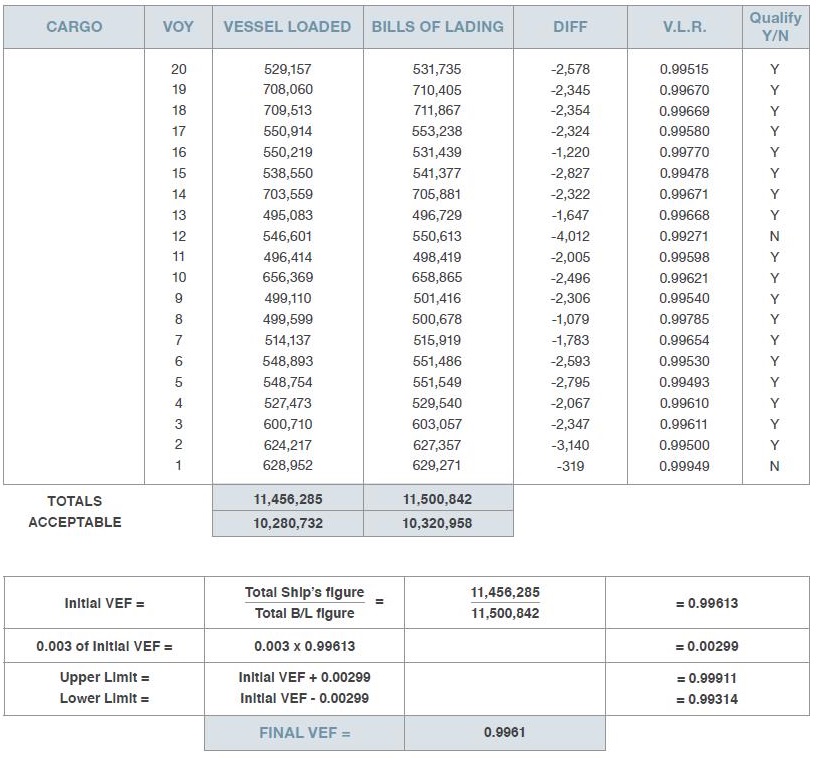Vessel Experience Factor
In this article we look at how vessel experience factor (VEF) is derived and applied.
The VEF is the historical difference in the ship and shore figures for a ship over a period of time. A VEF is used to assess the validity of quantities delivered to the ship that are derived from shore measurements.
Vessel capacity tables are often calculated from the vessel’s building plans, rather than based on accurate physical tank calibration measurements. This means that there are usually differences between the quantity of a cargo measured in a calibrated shore tank or by a custody transfer meter, and the quantity determined by vessel tank measurements.
For any given vessel a simple ratio can be found between the quantity of liquid measured on board the vessel and the corresponding measurement by a load or discharge facility. A historical compilation of this ratio, typically over 10 voyages, is known as the vessel experience factor (VEF).
In simple situations the application of a VEF is the principle way a Chief Officer is able to assess if the bill of lading quantity is reliable. But in more complicated situations; such as in cases where shore based measurements are not available, or are known to be inadequate for custody transfer and subject to agreement of interested parties, bill of lading or out-turn quantities may be determined based on vessel received or delivered quantities adjusted by the VEF.
There are at least three approved methods for calculating VEF as published by both the American Petroleum Institute (API) and the Institute of Petroleum (IP). More detailed examples of these calculations can be found in our loss prevention guide on ShipboardPetroleum Surveys.
A minimum of 5 qualifying voyages are needed to calculate a VEF – however, a larger number is desirable. A qualifying voyage
is a voyage in which the loaded quantity is within the range of +/- 0.0030 (or 0.3%) of the average ratio of all voyages – for example if the average of all voyages is 0.9961, all voyages with a ratio within the range from 0.99911 through 0.99314 would qualify, for example:

It is however worth bearing in mind the following voyages are not admissible as qualifying voyages:
- First voyages after dry dock,
- All voyages involving STS lightering operations,
- Voyages where bills of lading are based only on shipboard measurement,
- Voyages prior to any modification which have affected the ships carrying capacity,
- Voyages where vessel has loaded several parcels or voyages where vessel only part loaded to less than 75% capacity.
Once calculated, a VEF can then be applied to the ships figures which can then be compared to the shore figures as a measure of accuracy and confidence.
As an example, if a vessel gauges her tanks and the resulting calculations give a total quantity on board as 538,550 bbls but the shore figure presented is 541,377 bbls. The difference between the two figures is 2,827 bbls or 0.52% – a figure which would most likely prompt further investigation and protest.
If the vessel in question had a VEF of 0.9961 this, once applied to the vessels figures, would result in a ship figure of 540,658.6 bbls or a difference of 718.4 bbls which represents a difference of 0.14% – a figure which may be considered within acceptable industry standard margins. It is important to realise that an acceptable margin will vary from case to case. The accepted maximum 0.3% margin typically attributable to VEF is not necessarily a safe figure, but it is a good starting point.
It is also worth remembering that a VEF can change over time due to a number of factors such as:
- Change of trade (different grades and load ports)
- Accumulation of sediment and scale
- Dry docking preparation (de-scaling)
- Structural alteration in cargo spaces.
Further details on calculating and applying VEF can be read in our loss prevention guide on Shipboard Petroleum Surveys which may be downloaded from our Members section of our website.
General thoughts and guidance in dealing with discrepancies between ship and shore figures can be found in our loss prevention briefing on Liquid Cargo Shortage Claims which can be downloaded here.

 , you have now set your site language to English. If you'd like to change your language preference again, simply click on one of the other flags.
, you have now set your site language to English. If you'd like to change your language preference again, simply click on one of the other flags. を選択して頂くと、言語設定が日本語に切り替わります。設定変更後は以下の機能が利用可能です。
を選択して頂くと、言語設定が日本語に切り替わります。設定変更後は以下の機能が利用可能です。
 ,可将网站语言设置为中文。这能帮助您:
,可将网站语言设置为中文。这能帮助您:

